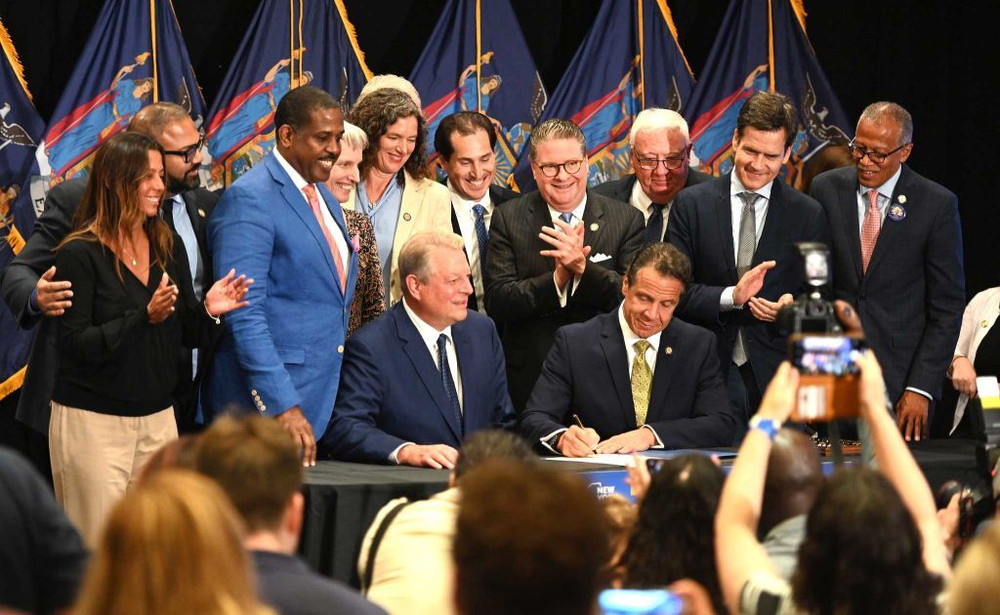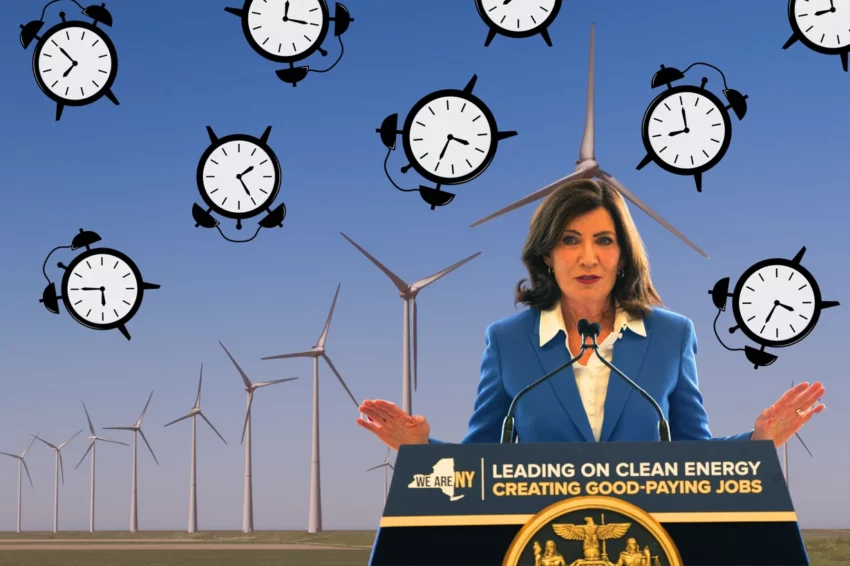This story originally appeared in New York Focus, a nonprofit news publication investigating power in New York. Sign up for their newsletter here.
NEW YORK STATE · June 19, 2024
Missed Deadlines Pile Up As New York’s Climate Law Turns Five
The state is blowing past key milestones on the way to its big emissions targets.
By Colin Kinniburgh , New York Focus
Five years after New York lawmakers passed a landmark bill to slash greenhouse gas emissions, the state has missed several of the law’s major deadlines — and it’s about to miss another.
When it passed on this day in 2019, the law was heralded as one of the most ambitious climate plans in the world. It established big, long-term mandates — committing the state to net-zero emissions by 2050 — and lots of smaller targets along the way. Now, the growing backlog of deadlines has left the law’s backers in dismay.
“We have all been aghast at just how horribly implementation has been going,” said Eddie Bautista, executive director of the New York City Environmental Justice Alliance. “In just five short years, we’ve gone from being visionary leaders to not being able to implement our own laws. It’s just insane.”
By January 1, New York was supposed to set regulations to achieve the law’s core emissions targets. Without them, the state can’t force polluters to comply. In December, it issued a “pre-proposal” for its main strategy to do so — putting a price on emissions through a program known as “cap and invest” — but it has yet to issue even a draft of the rules to establish the program.
By June 1, the state should have established a strategy to improve air quality in vulnerable communities. The Department of Environmental Conservation, responsible for crafting the plan, still has not done so. (The agency has been collecting data to inform the plan, and says it will host listening sessions this summer to solicit community input.)
And by July 1, the state is due to publish an official progress report on its renewable energy mandates, but it’s likely to be at least a few months late. The Department of Public Service, which is compiling the report, said a draft is not expected until at least early July. Then it has to go through a minimum 60-day public comment period before final publication.
Advocates who helped pass the Climate Leadership and Community Protection Act pin much of the blame for its halting progress on Governor Kathy Hochul, who oversees the agencies in charge of implementing the nuts and bolts of the law and has a bully pulpit to press for legislation needed to meet its targets.
“Any one of these [missed deadlines] would be understandable, but what they add up to is a really questionable set of leadership decisions,” said Stephan Edel, executive director of NY Renews, the coalition that led the charge for the CLCPA in 2019.
Hochul’s office did not respond to a request for comment.
More deadlines are coming up next year.
One represents a rare bright spot in New York’s energy transition: rooftop and community solar. The state has already put up 5.7 gigawatts’ worth, out of the six required by 2025. If this year is anything like the last few, New York will likely skate by the target before the year is out.
New York is also supposed to improve energy efficiency in buildings by 2025, shaving on-site energy use by roughly a tenth. The state has been chugging toward that goal, but not fast enough. At its current pace, it’s set to miss the mark.
Jessica Azulay, program director of the advocacy group Alliance for a Green Economy, pointed out that reducing energy use is key, because it makes it easier to meet one of the state’s most widely discussed targets: transitioning to 70 percent renewable energy by 2030. The less energy we use, the less renewables we need to meet that goal. The current outlook “is very problematic,” she said.
One more 2025 goal is also uncertain — this one self-imposed by the Hochul administration. In January, officials said the cap-and-invest program to price emissions would launch at the beginning of next year. But, asked this week if that was still the case, a DEC spokesperson declined to commit to a start date. Even if the agency were to issue draft rules this summer, the required public review would make it challenging to finalize them by year’s end.
Some advocates have begun to question whether Hochul will move forward with the program at all after her recent about-face on congestion pricing, in which she cited familiar concerns about costs. Hochul provoked a furor last year when she proposed overhauling how the state counts methane emissions, a measure that she said would reduce the costs a carbon cap could impose on New Yorkers. She was quickly forced to shelve that proposal, but her administration has since floated other cost-saving measures that could make the program less effective.
On top of already-missed deadlines, Hochul’s wavering does not bode well for the state’s ability to meet the bigger targets that loom in 2030 — notably, a 40 percent reduction in emissions from 1990 levels.
The large-scale renewable projects at the heart of those goals are still crawling along. Over the last two years, the outlook for New York’s wind and solar buildout has gotten worse, mainly due to the cancellation of major offshore wind projects. With current contracts, 59 percent of New York’s energy is projected to come from renewables by 2030, according to the state energy authority. That’s down from the 66 percent that the state projected in 2022.
Julie Tighe, president of the New York League of Conservation Voters, said cleaning up every other part of the economy “relies on us having a clean grid.”
“That is really the foundation of how we’re going to meet the goals overall,” said Tighe. “And frankly, that’s kind of the easiest part.” But she said economic headwinds, rather than government, were largely to blame for the recent setbacks in the state’s renewable buildout.

More broadly, Tighe — who worked at the DEC for 11 years and is in the running to take the agency’s top job — thinks it’s understandable that the Hochul administration has been slower-moving than the climate law prescribed.
“Sometimes the legislature sets very ambitious deadlines that don’t align with the timeframe it takes to develop rules,” she said.
That’s particularly true for rules governing a complex policy like an economy-wide price on carbon. “We’re not talking about just a narrow, single industry … we’re dealing with the entire economy,” Tighe said. “Doing it right is very important.”
Others are less willing to give the Hochul administration a pass.
“These were the deadlines set by the legislature. And they’re the minimum deadlines we need in order to be on track to be consistent with the Paris Agreement,” said Michael Gerrard, director of the Sabin Center for Climate Change Law at Columbia University. “We’re one of the most affluent states in the most affluent country in the world, and people are looking to us as an example.”
“In just five short years, we’ve gone from being visionary leaders to not being able to implement our own laws.”
—Eddie Bautista, New York City Environmental Justice Alliance
Gerrard said the delays could be grounds for a lawsuit against the administration, though no one has publicly threatened to take legal action yet.
Even some longtime critics of the climate law agree that the state is setting a bad precedent.
“As a general rule, when state government doesn’t follow its own law, it weakens the rule of law,” said Ken Girardin, research director at the Empire Center, a conservative think tank. He said the law’s heavy reliance on leadership from the executive branch is one of its main pitfalls, calling it “a blank check to the regulatory state.”
“What the Climate Act asked the DEC to do went far beyond what courts have held as the appropriate delegation of powers to state agencies,” Girardin said. Still, he, too, is eager to see Hochul’s draft rules for the cap-and-invest program — if only because he expects that they will be put to the test in court once they’re finalized.
Despite the law’s uneven progress, the Hochul administration routinely boasts of New York’s “nation-leading” climate action. In response to New York Focus’s questions for this story, the DEC highlighted several recent actions the state has taken to reduce emissions, including requiring all new cars sold after 2035 to be electric and tightening restrictions on two potent greenhouse gases used in refrigeration and electrical equipment.
“Pieces of this are moving along in the agencies,” said Raya Salter, an environmental justice advocate and lawyer who sits on the Climate Action Council, which was tasked with crafting the state’s climate plan. But at the same time, industry opposition to the most far-reaching parts of the climate law has ramped up, and politicians have not stepped up to see the mandates through, Salter said.
For the few climate hawks who raised doubts about the CLCPA when it passed, the last five years have been a troubling vindication.
“Targets and a process are nice, but what really needs to happen is the things that make it real,” said Pete Sikora, climate and inequality campaigns director at the advocacy group New York Communities for Change. “And it’s the things that make it real that are not happening.”

